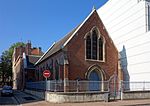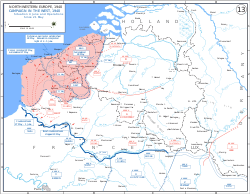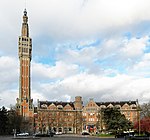Lille ( LEEL, French: [lil] (listen); Dutch: Rijsel [ˈrɛisəl]; Picard: Lile; West Flemish: Rysel) is a city in the northern part of France, in French Flanders. On the river Deûle, near France's border with Belgium, it is the capital of the Hauts-de-France region, the prefecture of the Nord department, and the main city of the European Metropolis of Lille.
The city of Lille proper had a population of 236,234 in 2020 within its small municipal territory of 35 km2 (14 sq mi), but together with its French suburbs and exurbs the Lille metropolitan area (French part only), which extends over 1,666 km2 (643 sq mi), had a population of 1,515,061 that same year (Jan. 2020 census), the fourth most populated in France after Paris, Lyon, and Marseille. The city of Lille and 94 suburban French municipalities have formed since 2015 the European Metropolis of Lille, an indirectly elected metropolitan authority now in charge of wider metropolitan issues, with a population of 1,182,250 at the Jan. 2020 census.More broadly, Lille belongs to a vast conurbation formed with the Belgian cities of Mouscron, Kortrijk, Tournai and Menin, which gave birth in January 2008 to the Eurometropolis Lille–Kortrijk–Tournai, the first European Grouping of Territorial Cooperation (EGTC), which has more than 2.1 million inhabitants.
Nicknamed in France the "Capital of Flanders", Lille and its surroundings belong to the historical region of Romance Flanders, a former territory of the county of Flanders that is not part of the linguistic area of West Flanders. A garrison town (as evidenced by its Citadel), Lille has had an eventful history from the Middle Ages to the French Revolution. Very often besieged during its history, it belonged successively to the Kingdom of France, the Burgundian State, the Holy Roman Empire of Germany and the Spanish Netherlands before being definitively attached to the France of Louis XIV following the War of Spanish Succession along with the entire territory making up the historic province of French Flanders. Lille was again under siege in 1792 during the Franco-Austrian War, and in 1914 and 1940. It was severely tested by the two world wars of the 20th century during which it was occupied and suffered destruction.
A merchant city since its origins and a manufacturing city since the 16th century, the Industrial Revolution made it a great industrial capital, mainly around the textile and mechanical industries. Their decline, from the 1960s onwards, led to a long period of crisis and it was not until the 1990s that the conversion to the tertiary sector and the rehabilitation of the disaster-stricken districts gave the city a different face. Today, the historic center, Old Lille, is characterized by its 17th-century red brick town houses, its paved pedestrian streets and its central Grand'Place. The belfry of the Hôtel de ville de Lille (Lille City Hall) is one of the 23 belfries in the Nord-Pas-de-Calais and Somme regions that were classified as UNESCO World Heritage Sites in July 2005, in recognition of their architecture and importance to the rise of municipal power in Europe.The construction of the brand-new Euralille business district in 1988 (now the third largest in France) and the arrival of the TGV and then the Eurostar in 1994 put Lille at the heart of the major European capitals. The development of its international airport, annual events such as the Braderie de Lille in early September (attracting three million visitors), the development of a student and university center (with more than 110,000 students, the third largest in France behind Paris and Lyon), its ranking as a European Capital of Culture in 2004 and the events of Lille 2004 (European Capital of Culture) and Lille 3000 are the main symbols of this revival. The European metropolis of Lille was awarded the "World Design Capital 2020".











